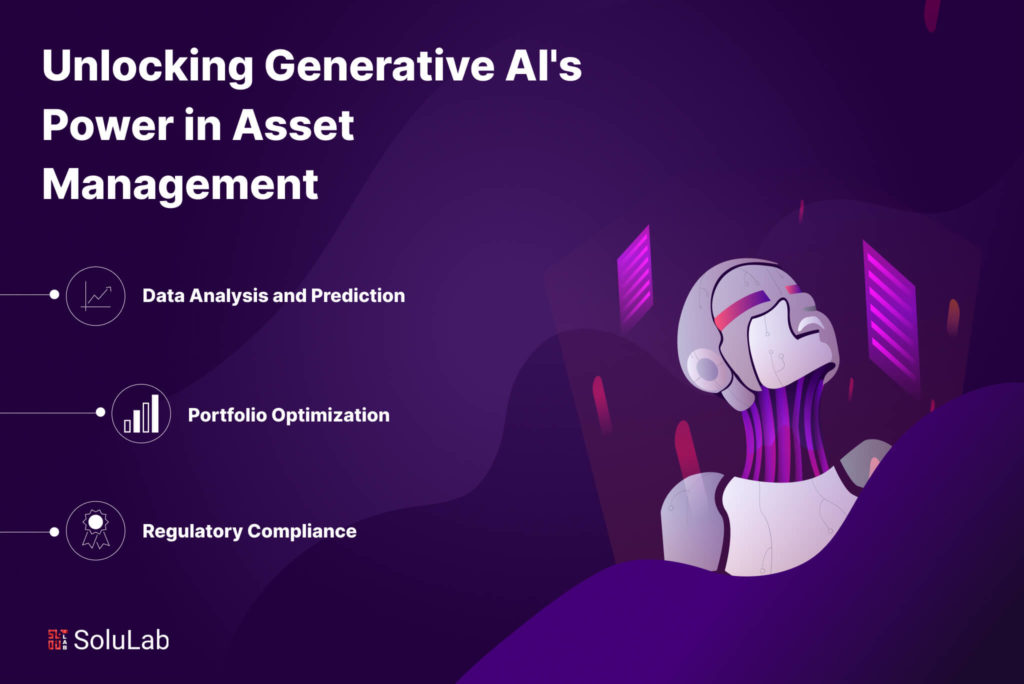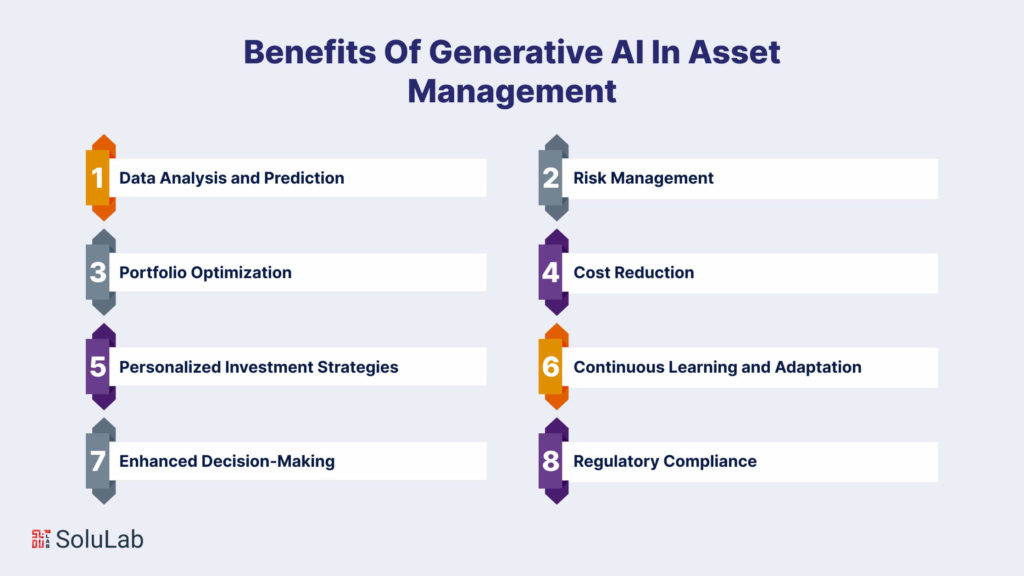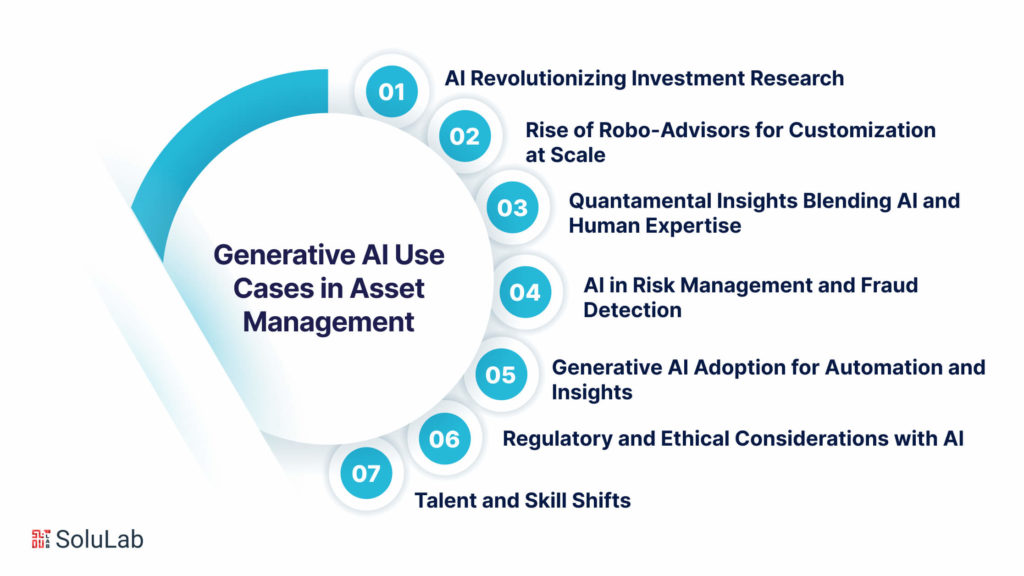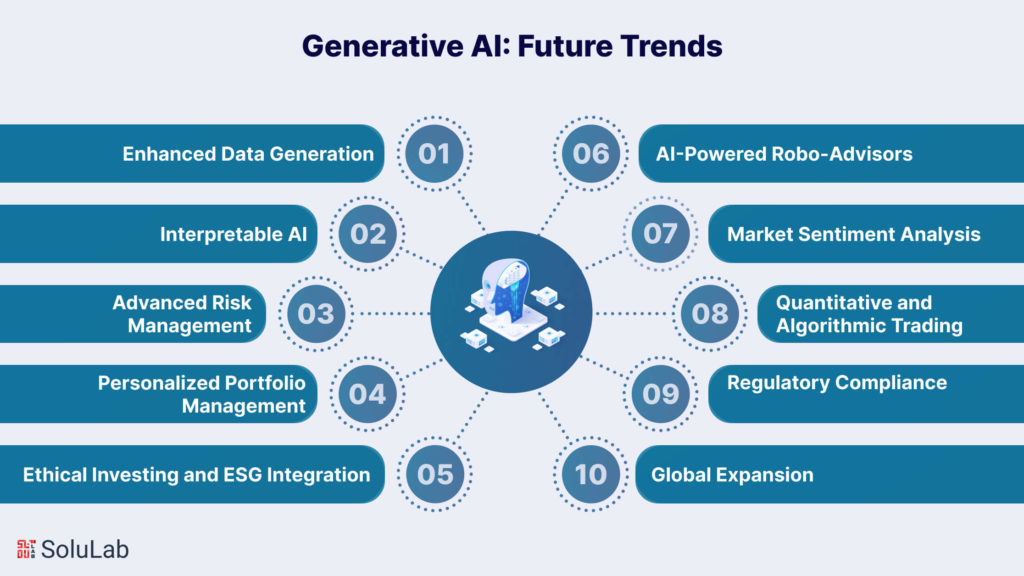
Generative AI, or GenAI, has the power to revolutionize the asset management sector.
Think of GenAI as a creative machine. Its underlying models soak in vast amounts of information, grasp context and meaning, answer abstract questions, and even generate new information, such as text and images.
These models learn rapidly. When deployed on a large scale, GenAI is in a prime position to improve asset management—a knowledge-based industry where information is consumed, processed, and created, and where trillions of dollars in client assets are managed.
This article delves into the various advantages of Generative AI. It demonstrates how GenAI empowers asset managers and firms in asset servicing to foster strategic growth, improve decision-making, and provide unparalleled client experiences.
Understanding Generative Artificial Intelligence
Generative Artificial Intelligence (AI) is a creative force that enables the generation of fresh content through text descriptions, existing images, video, or audio. It employs sophisticated algorithms to discern underlying patterns in the source material. By blending these identified patterns with their interpretations, Generative AI produces unique and representative artworks. The sources for this creativity can be explicitly provided assets or inferred from a text description, functioning as a specification or brief.
For example: Adobe Firefly generates images, showcasing the potential of Generative AI.
The Transformative Power of Generative AI
Generative AI stands out for its versatility and accessibility, demonstrating the ability to create novel, human-like output across various domains. Unlike “traditional” Artificial Intelligence applications such as playing chess or forecasting the weather, Generative AI holds vast real-world applications. Its transformative potential is likened to historical general-purpose technologies like the steam engine and electricity.
Benefits Of Generative AI In Asset Management

Asset management involves overseeing a company’s investments, ensuring optimal performance, and mitigating risks. The integration of generative AI in asset management brings about several benefits, making the process more efficient and effective. Here are eight key advantages that even a layman can understand:
-
Data Analysis and Prediction
Generative AI excels at analyzing vast amounts of historical data to identify patterns and trends. In asset management, this capability is invaluable for predicting market movements, assessing risks, and making informed investment decisions. By analyzing past data, the AI can provide insights into potential future market scenarios, helping asset managers make well-informed choices.
-
Risk Management
Asset management inherently involves risks, and generative AI plays a crucial role in assessing and managing these risks. AI algorithms can analyze various risk factors, such as market volatility, economic indicators, and geopolitical events, to provide real-time risk assessments. This enables asset managers to make proactive decisions to protect investments and minimize potential losses.
-
Portfolio Optimization
Generative AI can optimize investment portfolios by considering various factors such as risk tolerance, return expectations, and market conditions. The AI algorithms can suggest adjustments to the portfolio mix, helping to achieve a balance between risk and return. This optimization ensures that the portfolio aligns with the investor’s goals and adapts to changing market conditions.
Read Blog: A Brief Guide to AI in Portfolio Management
-
Cost Reduction
Implementing GenAI in asset management can lead to significant cost reductions. Automation of routine tasks, data analysis, and reporting allows asset managers to operate more efficiently. This not only saves time but also reduces the need for extensive human resources, leading to cost savings that can be passed on to investors or reinvested for better returns.
-
Personalized Investment Strategies
Generative AI can analyze individual investor profiles, considering factors like financial goals, risk tolerance, and time horizon. With this information, AI can generate personalized investment strategies tailored to each investor’s unique needs. This level of personalization enhances the client experience, increasing satisfaction and loyalty.
-
Continuous Learning and Adaptation
Generative AI continuously learns from new data and market developments. This adaptability allows asset management systems to stay current with evolving market conditions. The AI can quickly adjust investment strategies based on real-time information, ensuring that the portfolio remains aligned with the investor’s objectives.
-
Enhanced Decision-Making
By leveraging generative AI, asset managers gain access to sophisticated tools that augment their decision-making processes. AI algorithms can process vast amounts of information and provide actionable insights, empowering asset managers to make well-informed decisions promptly. This leads to better overall performance and outcomes for investors.
-
Regulatory Compliance
The financial industry is subject to various regulations, and adherence to these regulations is crucial for asset managers. One of the benefits of generative AI in asset management is that it can assist in monitoring and ensuring compliance by automating regulatory reporting, tracking changes in legislation, and flagging potential compliance issues. This reduces the risk of regulatory penalties and enhances the overall integrity of asset management operations.
Read Our Blog: An Ultimate Guide to Generative AI for Compliance
Popular Investment Firms Using Generative AI For Asset Management
-
JPMorgan Chase (JPM)
JPMorgan Chase is using AI to create a nifty software called “IndexGPT.” Similar to the popular ChatGPT, it helps pick investments that suit each client’s needs. They’re training this AI on a massive amount of 100 trillion words related to stocks, earnings reports, and analyst ratings.
-
Morgan Stanley
Morgan Stanley is teaming up with OpenAI to give their financial advisors quick access to a treasure trove of information. They’re using AI to tap into their research library, making it easier for advisors to help clients by saving time and making smarter decisions.
-
Vanguard
Vanguard’s CEO, Mortimer J. “Tim” Buckley, is embracing AI to revolutionize how they do business. He sees AI taking over routine tasks, freeing up time for more important things. Vanguard is already using AI as a robo-advisor, creating personalized retirement plans for clients using their ETFs.
-
Deutsche Bank
Deutsche Bank is teaming up with Nvidia Corp. for a “multiyear innovation partnership.” This means they’re embedding AI into their financial services, making things smarter and faster. The aim is to speed up risk analysis and let portfolio managers run different investment scenarios at high speed.
-
ING
ING, a Dutch investment firm, has been into AI for a while. Their bond-trading system, Katana, has made trade analysis 90% faster and cut operating costs by 25%. They’re committed to AI, recently hiring a chief analytics officer to keep pushing for seamless, secure, and digital services using analytics.
-
Fidelity
Fidelity, a giant in Boston, is going big on technology. They’re hiring hundreds of tech specialists and using AI to streamline operations. Their AI system, Saifr, is tackling compliance management, giving them a leg up in the regulated financial world. The Fidelity AMP platform, powered by AI and machine learning, is making investment recommendations for clients.
-
Wealthfront
Wealthfront started its AI journey in 2016 and has been expanding its services ever since. Their AI-driven tools now automatically rebalance portfolios, harvest tax losses, and provide holistic financial planning advice through Path. The Self-Driving Money strategy takes it a step further, automating users’ savings and investment plans, and making money management hassle-free.
Common Challenges Faced By Firms in Asset Management
The task of asset management does not come without its hurdles. Here’s a closer look at some of the primary challenges faced by asset management firms:
-
Data Quality and Reliability
Accurate and timely data is the lifeblood of asset management decision-making. Yet, ensuring the quality and reliability of data is no small feat. Issues such as incomplete or erroneous data can lead to flawed investment strategies and subpar performance. Additionally, integrating data from diverse sources poses challenges, necessitating thorough validation processes.
-
Market Volatility and Uncertainty
Financial markets are known for their inherent volatility, subject to swift changes influenced by economic indicators, geopolitical events, and shifts in investor sentiment. Navigating this uncertainty is paramount for asset managers, requiring them to make informed investment decisions that align with clients’ goals and risk tolerance.
-
Evolving Regulatory Landscape
The financial industry operates within a heavily regulated framework designed to ensure investor protection and market stability. Asset managers must stay abreast of constantly evolving regulations affecting their investment strategies, reporting requirements, and compliance practices. Non-compliance could lead to legal repercussions and harm one’s professional reputation.
-
Performance Consistency
Consistently delivering returns over time poses a challenge, especially in dynamic market conditions. Striking the delicate balance between risk and return is complex, and a period of underperformance can result in client dissatisfaction and potential fund outflows.
-
Managing Investor Expectations
Investors often harbor high expectations for returns, and effectively managing these expectations is crucial. Clear communication becomes paramount in explaining the potential risks associated with different investment strategies and establishing realistic performance benchmarks.
-
Customization vs. Scalability
Asset managers are always struggling with finding the right equilibrium between providing tailored investment solutions for individual clients and maintaining scalability to efficiently manage a larger client base.
To address these challenges, asset managers are increasingly turning to GenAI in asset management.
Generative AI Use Cases in Asset Management

Artificial Intelligence (AI) emerged as a game-changer in several key areas. Here are several Generative AI use cases in asset management.
-
AI Revolutionizing Investment Research
Traditional investment research processes, often manual, are struggling to keep pace with the demands of big data and fast-moving markets. AI, with its automation capabilities, becomes essential for asset management firms aiming to enhance speed without compromising quality. AI-powered market intelligence platforms offer access to top-tier data sources, sentiment analysis through Natural Language Processing (NLP), intuitive dashboards, intelligent search, automated alerts, and predictive data analytics.
-
Rise of Robo-Advisors for Customization at Scale
Robo-advisors, fueled by AI algorithms, provide automated and personalized investment advice. Their revenue has seen a 15X increase from 2017 to 2023, offering scalability to previously underserved customer segments. While human advisors remain crucial for investor trust, finding the right balance between robo-advisors and human perspectives is vital.
-
Quantamental Insights Blending AI and Human Expertise
Quantamental insights combine machine learning and AI with human knowledge, offering a harmonious blend for investment decision-making. This approach allows asset managers to leverage AI for data analysis while preserving the unique human perspective crucial to informed decisions.
-
AI in Risk Management and Fraud Detection
AI-powered tools excel in real-time risk management, identifying anomalies and potential risks that might go unnoticed by humans. Machine learning algorithms contribute to detecting irregular trading patterns, market disruptions, and fraudulent activities, enhancing market integrity and investor confidence.
-
Generative AI Adoption for Automation and Insights
Generative Artificial Intelligence (genAI) is gaining prominence for automating tasks like data entry, report generation, and compliance monitoring in asset management. It aids in generating insights by identifying patterns and trends that might elude human observation, thus facilitating better investment decisions and risk management.
-
Regulatory and Ethical Considerations with AI
The increased reliance on AI prompts regulatory and ethical considerations. Transparency and explainability are paramount as AI systems play a more significant role in investment decisions. Asset managers must justify AI model usage, ensuring it remains unbiased and complies with market regulations.
-
Talent and Skill Shifts
The integration of AI necessitates a shift in required skills for asset managers. Proficiency in data science, machine learning, and AI techniques is now essential for developing and implementing AI-driven investment strategies. Collaboration between financial professionals and data scientists is on the rise, emphasizing the need for interdisciplinary expertise.
How Generative AI Can Help Businesses?
Marketing Managers: Designing Engaging Content
Marketing managers can leverage GenAI to design captivating cover pages for reports and create engaging videos for customer presentations. This tool enhances the visual appeal of materials, making them more impactful for retail and institutional customers investing in equities, fixed income, and alternative assets.
Research Analysts and Product Designers: Informed Decision-Making
Research analysts and product designers use GenAI to analyze a plethora of information, from research reports to market data, aiding in the creation of comprehensive research reports. They can also develop, test, and execute automated risk-adjusted investment strategies. GenAI assists in identifying limitations in existing strategies, leading to the formulation of diversified and profitable alternatives.
Traders, Portfolio Managers, and Risk Analysts: Enhancing Efficiency
GenAI improves efficiency in portfolio management activities, including:
- Portfolio analysis based on geography, industry, sector, and ESG parameters.
- Personalized recommendations for diverse investments.
- Risk analysis covering liquidity, credit, and market risks.
- Tail risk analysis for special situations.
- Creating training data for stress test scenarios.
- Performance reports through storytelling for personalized investor communication.
Alternative Asset Managers: Identifying High-Impact Use Cases
GenAI assists alternative asset managers in identifying emerging trends and disruptive technologies by consolidating and comparing information on potential companies for investment. It streamlines data analysis across industries and sectors, supporting comprehensive competitive analysis.
Asset Servicing Firms/Fund Administrators: Streamlining Data Solutions
GenAI enhances visibility into consolidated enterprise data through question-and-answer mechanisms, providing a more efficient way for business users to access and analyze data within asset servicing firms’ data solution platforms.
Customer Service Representatives: Improving Efficiency
GenAI aids customer service representatives by presenting relevant responses during customer queries, leading to efficient issue resolution, improved customer satisfaction, lower costs, and quicker employee onboarding.
Internal Communication and Language Barriers: Enhancing Collaboration
In global organizations with language barriers, GenAI streamlines day-to-day tasks, including information gathering in English, facilitating smoother internal communication.
Popular Generative AI Models
-
Generative Adversarial Networks (GANs)
Generative Adversarial Networks are powerful tools in finance for creating artificial time series data that closely resembles real market information. This synthetic data is beneficial for simulating market scenarios, stress-testing investment strategies, and expanding datasets for training predictive models. Using GANs enhances the robustness and adaptability of financial models, supporting better decision-making in asset management and trading.
-
Variational Autoencoders (VAEs)
Variational Autoencoders, or VAEs, play a crucial role in asset management by aiding in feature extraction, risk assessment, portfolio optimization, and market sentiment analysis. When combined with algorithms like Reinforcement Learning, VAEs help construct optimized portfolios, simulate market scenarios, and identify anomalies in asset behavior. While VAEs are a valuable tool, their effectiveness depends on specific applications and data quality. They are often used alongside traditional financial models and domain expertise to make informed investment decisions in dynamic financial markets.
-
Auto-Regressive Models
Auto-Regressive, or AR, models are valuable in asset management for forecasting time series data. These models capture temporal dependencies in historical asset price data, enabling predictions of future price movements. AR models, often extended with components like GARCH for volatility modeling, assist in risk assessment and portfolio optimization. By forecasting asset returns and volatility, they help manage portfolios and adjust strategies in response to changing market conditions, ultimately contributing to the development of more informed investment strategies.
-
Transformer-Based Models
Transformer-based models, known for their effectiveness in handling sequences, are valuable in asset management for capturing complex relationships in financial data. They excel in modeling both short and long-term dependencies, making them suitable for predicting asset prices and optimizing portfolios. Transformers efficiently process large-scale financial data, extract meaningful features, and detect patterns, improving decision-making in trading strategies. These models can also be applied to natural language processing tasks, facilitating sentiment analysis of news and social media data for sentiment-based market strategies. By leveraging these capabilities, Transformer-based models contribute to enhancing asset management strategies through improved data-driven insights and decision-making processes.
Generative AI: Future Trends

The future of GenAI in asset management holds exciting possibilities, driven by evolving technology and emerging trends:
- Enhanced Data Generation: Generative AI models are expected to excel in producing synthetic financial data closely resembling real market conditions. This artificial data will prove invaluable for backtesting strategies, conducting stress tests, and training machine learning models, overcoming limitations posed by scarce historical data.
- Interpretable AI: As AI’s role in asset management expands, there will be a heightened focus on making AI models more interpretable and explainable. Future developments in generative AI aim to enhance transparency in decision-making, providing asset managers with insights into why specific strategies or recommendations are generated.
- Advanced Risk Management: Generative AI models will play a crucial role in elevating risk management practices. By offering more accurate simulations of market scenarios, these models will empower asset managers to devise resilient strategies capable of withstanding extreme events and unforeseen challenges.
- Personalized Portfolio Management: Generative AI will enable asset managers to deliver highly personalized investment strategies tailored to individual clients. By leveraging improved predictive capabilities, these strategies will align with clients’ risk tolerance, financial goals, and ethical preferences.
- Ethical Investing and ESG Integration: Generative AI is poised to streamline the integration of Environmental, Social, and Governance (ESG) criteria into investment decision-making. It will identify ESG-compliant investments and screen out non-compliant ones, aligning portfolios with ethical values.
- AI-Powered Robo-Advisors: The continued growth of AI-powered robo-advisors is anticipated, with generative AI enhancing these platforms’ sophistication. Retail investors can expect increasingly intelligent and automated investment advice.
- Market Sentiment Analysis: Natural Language Processing (NLP) techniques within generative AI will advance market sentiment analysis. AI models will adeptly process vast textual data from news, social media, and financial reports, providing accurate insights into market sentiment.
- Quantitative and Algorithmic Trading: Generative AI models will become integral to quantitative and algorithmic trading strategies, assisting in developing adaptive, data-driven algorithms capable of navigating complex market conditions.
- Regulatory Compliance: Generative AI will play a pivotal role in automating compliance tasks, and ensuring adherence to ever-evolving financial regulations. This will minimize the risk of human errors and costly regulatory breaches.
- Global Expansion: The adoption of generative AI in asset management transcends geographical boundaries, becoming a global trend with wider acceptance in various financial markets. This fosters a more level playing field for investors worldwide
Useful Tips to Start Your AI Journey
Embarking on a successful AI journey is crucial for business survival and growth. Here are 7 practical tips to guide you in starting your AI initiatives effectively:
- Right-Size Your Start: Begin at a scale that aligns with your company’s size, avoiding the pitfalls of overhyping and overreaching. Starting modestly allows for a more manageable and successful implementation.
- Stay Informed: Keep abreast of AI technology developments and understand how they can seamlessly integrate into your existing data, technology stack, processes, and operational needs. This ongoing awareness ensures you harness the latest advancements effectively.
- Consider Workforce Impact: Delve into how AI will influence your workforce, impacting talent acquisition and retention. Understanding these dynamics helps in preparing your team for the changes AI brings and ensures a smooth transition.
- Focus on Use Cases: Evaluate practical, actionable use cases for AI implementation. Instead of merely applying technology to a problem, envision the tangible business benefits that AI can bring to your organization.
- Define Internal Use Cases: Identify internal scenarios where AI can make a meaningful impact. Assemble a small, dedicated team of individuals enthusiastic about AI, fostering a collaborative environment for innovation and exploration.
- Embrace Mistakes and Learn: Adopt a mindset of experimentation. Be open to making mistakes, fail fast, learn from them, and iterate. This iterative approach allows for continuous improvement while staying focused on your ultimate objectives.
Take Away
Generative AI is set to transform asset management, bringing forth an era marked by efficiency, precision, and adaptability. Those asset managers who adopt and utilize generative AI will have a clear advantage in navigating the intricate landscape of financial markets as technology progresses. Incorporating Generative AI into asset management signifies a revolutionary change in decision-making and portfolio management. Embracing these technological advancements opens the door to limitless innovation and growth in the asset management industry.
Seeking a trustworthy partner to collaborate during your AI journey is crucial. A reliable partner can provide valuable insights, guidance, and support, contributing to the overall success of your AI initiatives. Choosing SoluLab as your AI journey partner ensures seamless and successful integration of artificial intelligence into your business strategies. With a proven track record of delivering innovative solutions, SoluLab brings a wealth of experience in navigating the evolving landscape of AI technology. Their expertise spans various industries, allowing for tailored solutions that precisely fit your business needs.
SoluLab’s commitment to staying at the forefront of AI advancements guarantees you access to cutting-edge technologies. As your trusted AI development partner, SoluLab is dedicated to guiding you through every step of your AI implementation, fostering growth, efficiency, and sustained success.
Get in touch today!
FAQs
1. What is Generative AI in the context of Asset Management?
Generative AI in Asset Management refers to the application of artificial intelligence techniques, particularly generative models, to assist in the creation, analysis, and optimization of investment portfolios. These models can generate synthetic data, simulate market scenarios, and aid in decision-making processes within the asset management industry.
2. How can Generative AI enhance portfolio optimization in Asset Management?
Generative AI can improve portfolio optimization by simulating a wide range of market conditions and generating synthetic data for various asset classes. This enables asset managers to assess the robustness of their portfolios under different scenarios, identify potential risks, and optimize asset allocations to achieve better performance.
3. What role does Generative AI play in risk management for asset portfolios?
Generative AI contributes to risk management by generating synthetic datasets that help assess and model different risk factors. Asset managers can use these models to simulate the impact of market fluctuations, economic events, or other uncertainties on their portfolios. This aids in developing more resilient and adaptive risk management strategies.
4. How can Generative AI assist in market forecasting and trend analysis for asset management?
Generative AI models can analyze historical market data and generate forecasts based on learned patterns and trends. This assists asset managers in making informed decisions about potential market movements, identifying investment opportunities, and adapting their strategies to changing market conditions.
5. What challenges and ethical considerations are associated with the use of Generative AI in Asset Management?
While Generative AI in asset management offers valuable tools, challenges include the potential for biased model outputs, overreliance on historical data, and the interpretability of complex models. Ethical considerations involve ensuring fairness in decision-making, transparency in model behavior, and addressing issues related to data privacy and security.






